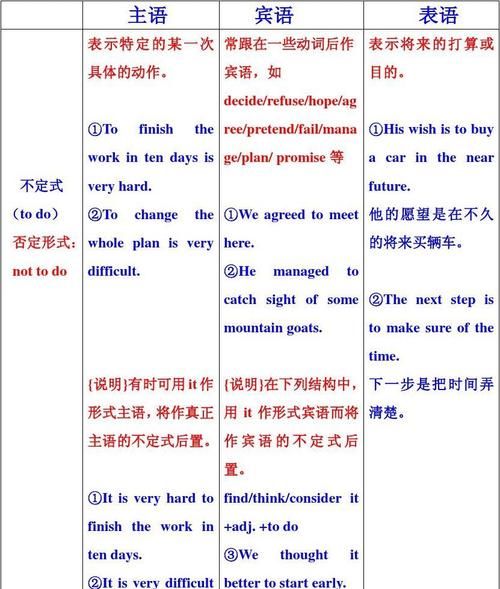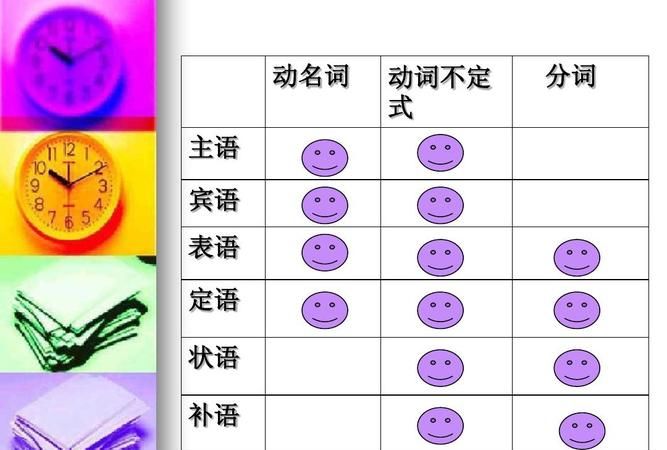本文目录
定语从句和非谓语动词的转换
定语从句和非谓语动词解析:
熟悉非谓语动词的同学们应该都知道,非谓语动词包括to do, doing和done,这三类动词的特别之处就在于它们可以在句子里面充当除谓语以外的任何成分,其中一个非常重要的用法就是位于名词后作为名词的后置定语,比如:
The semiarid lands bordering the deserts exist in a delicate ecological balance and are limited in their potential to adjust to increased environmental pressures.
以上例句里的非谓语动词的短语“bordering the deserts”就是用作定语来修饰前面的名词短语“the semiarid lands”。
很多同学很熟悉定语从句,而对非谓语动词的用法总是有种望而却步的感觉。
但是细心的同学肯定会发现,其实在语法家族里,当将非谓语动词用作后置定语的时候,它与定语从句的.用法是一样的,两者是名副其实地长相不同,但却有血缘关系的“远房表亲”。比如,上面的例子我们就可以改写成定语从句:
The semiarid lands which border the deserts exist in a delicate ecological balance and are limited in their potential to adjust to increased environmental pressures.
再如以下带有非谓语动词短语的句子:
Theorist adopting the psychodynamic approach hold that inner conflicts are crucial for understand human behavior, including aggression.
我们可以改成定语从句:
Theorist who adopt the psychodynamic approach hold that inner conflicts are crucial for understand human behavior, including aggression.
又如,以下的两个句子的意思是相同的:
1.What audience came to see was the magic made possible by trick photography and manipulation of the cinema.
2.What audience came to see was the magic that was made possible by trick photography and manipulation of the cinema.
在很多情况下,学生更容易理解定语从句。所以,下次在处理包含非谓语动词短语的长难句时,不妨将其改写成定语从句,方便我们理解长难句。
那么问题来了,定语从句和作定语的非谓语动词之前是否有某种特定的对应关系呢?答案是有的,关系如下:
Which be to do = to do(表主动/将来)
Which do... = doing...(表主动)
Which be done... = done...(表被动)
为方便大家记忆,哈耶普的老师为大家准备了一个“玫瑰凋谢理论”:
1.The roses to be planted in the garden are fading away.
2.Tho roses which are to be planted in the garden are fading away.
1.The roses growing in the garden are fading away.
2.The roses which grow in the garden are fading away
1.The roses planted in the garden are fading away.
2.The roses which are planted in the garden are fading away

如何判断它是定语从句
定语从句有明显的先行词(名词或代词),还有引导从句的关系代词或副词(which,that/where,why,when)
1. 关系代词(which, that)
它们所代替的先行词是事物的名词或代词,在从句中可作主语、宾语等,例如: (1) A prosperity which / that had never been seen before appears in the countryside. 农村出现了前所未有的繁荣。(which / that在句中作主语) (2) The package (which / that) you are carrying is about to come unwrapped. 你拿的包快散了。(which / that在句中作宾语,作宾语时关系词可省略)
2.关系副词(在句中作状语:why/where/when)
关系副词=介词+关系代词 why=for which where=in/ at/ on/ ... which (介词同先行词搭配) when=during/ on/ in/ ... which (介词同先行词搭配) ●where是关系副词,用来表示地点的定语从句,why是用来表示原因的定语从句,when用来表示时间的定语从句。如: (1) Shanghai is the city where I was born. (2) I still remember the day when I first came to the school. (3) Please tell me the reason why you missed the plane.
而非谓语,顾名思义,就是不能做谓语的词或结构,包括动词不定式,动词ing结构(动名词、现在分词),过去分词等。如:(1)I'm glad to meet you. (2)Seeing is believing. 眼见为实。/The problem being discussed is very important. 正在被讨论的问题很重要。 (3)Our class went on an organized trip last Monday. 上周一我们班开展了一次有组织的旅行。
详细的可以问我……或见以下网址:

高三语法总结非谓语动词及定语从句
非谓语动词包括1动词不定式2动名词3分词(包括现在分词 过去分词)
动词不定式可做除谓语外的其他成分.
动名词和现在分词的用法区别是一个难点.注意两个所做的成分不同及用法上的不同.
动名词偏向于名词的使用方法,现在分词偏向于形容词的使用方法.
现在分词和过去分词的用法区别也是一个考点.
定语从句:简单说来就是一个从句在主句中做定语.
分为:限定性和非限定性 常见的是限定性定语从句(它和主句的关系密切去掉则影响这个句意的表达)非限定性定语从句(常由which引导由逗号隔开) 还要注意限定性定语从句和非限定性定语从句之间的句意细微差别.

定语从句
定语从句 定语从句是在句子中起形容词作用的主谓结构,通常修饰它前面的名词或代词,即它的 先行词。定语从句是由关系代词和关系副词引导的。 1.关系代词引导的定语从句 ⑴引导定语从句的关系代词有:who,whom,whose,which,that。 ⑵关系代词在从句作主语、宾语、定语和表语的作用;当作宾语时,关系代词常常可省 略。如: This is the girl(whom)you’ve been looking for. ⑶当定语从句所修饰的先行词是人或人格化的动物时,引导词用who,whom或whose; 如果先行词是无生命的东西,用关系代词which;而that可用于以上两种情况。 The man who robbed you has been arrested. Which还可以指婴儿、动物和表示单数意义的集合名词,如: The baby(which) the nurse brought in was Mary’s child. ⑷关系代词that和which的语法区别 当先行词的前面有形容词的最高级修饰时,通常用that而不用which。如: The final match is one of the most exciting football games that I have ever seen. 当定语从句所修饰的先行词的前面有all,any,little,only,much等修饰时,或者这些先行 词本身就是all,one,little,much,nothing等不定代词时,通常用that而不用which。 I am interested in all that you have told me. 当定语从句作介词的宾语时,只能使用which而不用that。 The world in which we live is in constant motion and in constant change. 当定语从句是与代词、数词或名词词组连用引导非限定性定语从句时,只能使用which 而不用that。 I bought a dozen eggs, five of which broke when I dropped the box at my door. 当先行词的前面有the+only(first,last,same,next,very)等词修饰时,通常用that而不用 which。 This is the very movie that I want to see. 当被用来指代整个句子,引导非限定性定语从句时,只能使用which而不是that。 Things then improved,which surprises me. 2.关系副词引导的定语从句 ⑴引导定语从句的关系副词有:when,where,why,how等。 ⑵关系副词when,where,why在从句中作状语时,可用“介词+which”来替代。如: The reason why(=forwhich) he is in hospital hasn’t been known yet. 3.限定性定语从句和非限定性定语从句 限定性定语从句与先行词关系密切,用来描述主句所涉及的人或物的具体情况,与主句 不可分割。这种从句在口语中前后没有停顿,在文字中前后没有逗号。 非限制性定语从句与先行词之间的关系比较松散,为主句所描绘的人或物提供一些附加 情况,并非绝对必要。这种从句在口语中有停顿,在文字中往往用逗号与主语隔开。 另外,非限定性定语从句可用which,who,whose,when,where等来引导,但不可以用that 来引导。如: The wine,which was in the cellar,was ruined.(非限定性) The wine which (that)was in the cellar was all ruined.(限定性) 在限定性定语从句中,关系代词有时可省略;但是在非限定性定语从句中,关系代词不 能省略。 状语从句 在句子中起状语作用的句子叫做状语从句。状语从句可以位于句首、句中或句末。位于 句首时,从句末通常有逗号与主句隔开;位于句中时,从句的前后都必须有逗号;位于句末 时,从句的前面可以不用逗号。状语从句按意义可分为时间、地点、原因、条件、让步、方 式、比较、目的和结果等状语从句。状语从句由从属连词引导。 1.时间状语从句 引导时间状语从句的连词有:after,as,before,once,since,till,until,when,whenever, now(that),assoonas,aslongas,nosooner…than等。有些名词短语也可以引导状语从句,如: every time, the moment,the instant。 When I saw her,she was watching closely at the photo on the wall. as,when和while都可以表示主句中动作发生的背景,也可以表示主句的动作与从句的 动作同时发生,如: As he stood there,he heard what they were talking about. till和until在主句谓语为持续性动词的肯定式时,作“直到……为止”解,在主句谓语 为瞬间动词的否定式时作“直到……才”解,如: Let’s wait till/until the rain stops. once,directly,the moment,th einstant和as soon as都作“一…就”解,通常可以互换, 如: Once you understand this, you will surely make rapid progress in your study. 由副词加从属连词no sooner…than,hardly/barely/scarcely…when等引导的时间状语从 句,如果no sooner,hardly,barely,scarcely前置句首,主语与谓语须用倒装结构。如: Hardly had the film started when they came. 2.地点状语从句 地点状语从句通常由where,wherever引导,如: Where there is a will,there is a way. 从属连词还能与any,no,every等一起构成复合句,引导地点状语从句。如: Everywhere you go,you will be warmly welcomed. 3.方式状语从句 引导方式状语从句的连词有as,as if,as though等,从句通常位于主句之后,如: He had never blushed as she blushed then.(as作“按照”或“像”解。) as if和as though都做“好象”解,两者可以互换,从句既可用陈述语气(表示可能符 合事实的情况),又可用虚拟语气(表示与事实不符的情况),如: I remember the whole thing as if it happened yesterday. 4.条件状语从句 引导条件状语从句的连词有:if,unless,as/so long as,suppose(that),supposing(that),in case,when等。条件状语从句可以分为真实条件状语从句和非真实条件状语从句。 ⑴真实条件句 真实条件句表示现实或可能的情况,由if引导,它的主句可以是陈述句,疑问句或祈 使句,可置于主句之前或之后。 If you heat ice,it melts. unless引导的否定条件状语从句,在意义上相当于if…not,如: Don’t come unless I telephone. as/so long as,provided/providing(that)意为“只要、如果”,如: You can borrow this pen as long as you can keep it well. in case在英国英语中表示目的,在美国英语中可表示条件,意为“如果、万一”,如: In case the house burns down,we’ll get the insurance money. ⑵非真实条件句请参阅第十一章“虚拟语气”。 5.让步状语从句 引导让步状语从句的连词有:although,though,even if,even though,if,for all that,when, while,whether…or,whatever,no matterwhat等。 although和though意义一样,都作“虽然、即使”解,都表示让步,一般情况下可互换 使用,只是although语气较重,大多置于句首。如: They are generous though they are poor. even if和even though都作“即使”解,两者可以互换使用,如: She insisted on her own opinion even though/even if he was wrong. if作“即使、虽然”解,也表示让步,如: If he is wrong,he is honest. whether…or作“不论……是否”或“不论……还是”解,如: You don’t have to worry me whether I am well or ill. 为了强调让步意义,在正式文体或文学作品中,常用as引导让步从句,从句的补语或 状语置于句首。如: Strong as you maybe,you cannot lift it. 词尾为-ever的wh-词可以与“nomatter+wh-词”互换使用,作“无论……”解,后者 常用于口语中,如: Whoever/No matter who rings,tell him I’m out. 由whenever,wherever,however引导的从句,也可以分别看作时间状语从句、地点状语 从句和方式状语从句。把它们当作让步状语从句是因为它们常有no matter when(where,how) 的含义。 6.原因状语从句 原因状语从句通常由because,since,as,when now(that),seeing(that),considering(that)等 引导。 because,since和as三者的区别如下: because的语势最强,其次是since,再次是as。 because可以回答why引导的特殊问句,而since和as不能。 because引导的从句可以被just,only,simply等副词修饰,也可以用并列连词构成并列的 because从句,而since和as则不能。如: We pardoned him only because he was still young. for表示原因时,作“因为”解,多用于正式文体,有时可以与because换用,但for从 句只能置于主句之后。如: She didn’t go to school,for/because she was ill. now(that)和seeing(that)都作“既然”解,通常可与since或as换用,如: Now(that)you have come,you may as well stay. 7.结果状语从句 引导结果状语从句的连词有:so that,so…that,such that,such…that,that等。 当从句前面有逗号时,sothat中that可省略,如: It was dark,so(that)we could see nothing in front of us. “So+形容词/副词+that”是引导结果状语从句的常用结构,如: He talked so loud that he annoyed the speaker. “such(a)+形容词+名词+that”与“so…that”的意义相同,如: It was such a hot day that people could not go out. that可以单独引导结果状语从句,如: Theq uestion is of great importance that it cannot be neglected. 8.目的状语从句 引导目的状语从句的连词有:in order that,so that,so,that,in case,for fear that,lest等。 in order that与so that的意义和用法基本相同,in order that多用于正式文体,常表示经 过认真考虑的目的,如: In order that he would have more space for painting,he bought a big house. So和that可视为so that的省略形式,但不如so that常用,如: Bring it closer so/that I may see it better. for fear that,in case和lest都表示否定的目的,相当于so that…not或in order that…not, 作“以免、以防”解。 He wrote the name down for fear that he should forget it. lest限于正式文体,它所引导的从句中的谓语动词多用shouldbe型或be型虚拟形式, 如: He hid the box lest it (should)be stolen. incase引导的从句谓语既可以用虚拟形式,又可用陈述语气,如: Better take more clothes in case it i scold.

以上就是关于非谓语和定从,定语从句和非谓语动词的转换的全部内容,以及非谓语和定从 的相关内容,希望能够帮到您。

